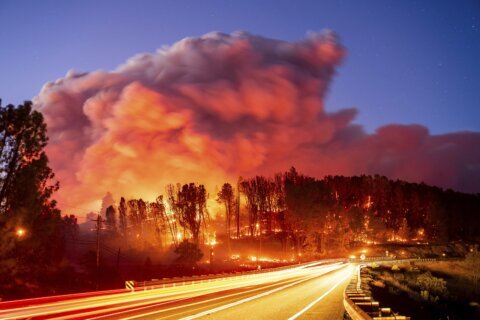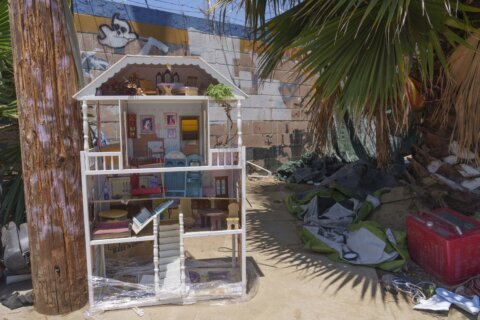HONOLULU (AP) — A magnitude 5.7 earthquake struck the world’s largest active volcano on Friday — Mauna Loa on the Big Island of Hawaii — knocking items off shelves and cutting power in a nearby town but not immediately prompting reports of serious damage.
The earthquake, which didn’t cause a tsunami and which the U.S. Geological Survey initially reported as magnitude 6.3, was centered on Mauna Loa’s southern flank at a depth of 23 miles (37 kilometers), 1.3 miles (2 kilometers) southwest of Pahala.
“It shook us bad to where it wobbled some knees a little bit,” said Derek Nelson, the manager of the Kona Canoe Club restaurant in the oceanside community of Kona, on the island’s western side. “It shook all the windows in the village.”
There was a power outage affecting about 300 customers in Naalehu that appeared to be related to the earthquake, said Darren Pai, spokesperson for Hawaiian Electric Company.
The earthquake struck after 10 a.m. local time, less than two hours before an unrelated quake with a preliminary magnitude of 4.6 shook Southern California.
Mauna Loa last erupted in late 2022. It’s one of five volcanoes that make up the Big Island, which is the southernmost in the Hawaiian archipelago.
Earthquakes can occur in Hawaii for a variety of reasons, including magma moving under the surface. In Friday’s case, the Hawaiian Volcano Observatory said the likely cause was the weight of the Hawaiian Islands bending and stressing the Earth’s crust and upper mantle.
That’s what caused a magnitude 6.9 earthquake that struck off Kiholo Bay on the Big Island’s northwest coast in 2006. That temblor damaged roads and buildings and knocked out power as far away as Honolulu, on the island of Oahu, about 200 miles (322 kilometers) to the north.
Helen Janiszewski, an assistant professor in the University of Hawaii at Manoa’s Department of Earth Sciences, said the Hawaiian Islands lie on the Pacific oceanic tectonic plate and have some of the world’s biggest volcanoes.
“So there’s a huge amount of mass of rock associated with the islands and because of that, it’s actually enough to slightly displace the Pacific oceanic plate beneath the islands,” she said. “And that force causes earthquakes sometimes.”
This type of earthquake tends to occur several tens of kilometers beneath the Earth’s surface in the mantle, Janiszewski said. Quakes caused by moving magma tend to hit more shallow depths.
The observatory said Friday’s earthquake didn’t affect either Mauna Loa or a neighboring volcano, Kilauea.
There were no immediate reports of damage to telescopes on the summit of Mauna Kea, another nearby volcano that has some of the world’s most advanced observatories for studying the night sky.
Jessica Ferracane, a spokesperson at Hawaii Volcanoes National Park, said there was no apparent damage to its roads or visitor centers. Earthquakes are not uncommon, she said, but this one was “much more intense” than usual.
The Hawaiian Islands have been built by successive volcanic eruptions over millions of years. The vast majority of earthquakes in Hawaii occur on and around the Big Island. About once every 1.5 years, there is an earthquake in the state that is magnitude 5 or greater, according to the Hawaiian Volcano Observatory.
The Big Island is mostly rural and hosts cattle ranches, coffee farms and resort hotels. But it also has a few small cities, including the county seat of Hilo, population 45,000.
Friday’s earthquake could be felt in Honolulu. Big Island Mayor Mitch Roth was at a cardiologist appointment there and initially thought he was experiencing side effects from a procedure: “All of a sudden I felt like I was getting dizzy.”
He said he immediately got on the phone with his emergency management officials when he realized it was an earthquake, and that he was heading to the Honolulu airport to try to get an earlier flight back.
Grace Tabios, the owner of Will and Grace Filipino Variety Store in Naalehu, said the shaking knocked down her husband, who was working at their coffee farm in Pahala. At the store, jars of mayonnaise and medicine from the Philippines fell off the shelves.
“Some things fell down but didn’t break,” Tabios said.
___
Associated Press writers Mark Thiessen in Anchorage and Becky Bohrer in Juneau, Alaska, contributed to this report.
Copyright © 2024 The Associated Press. All rights reserved. This material may not be published, broadcast, written or redistributed.







